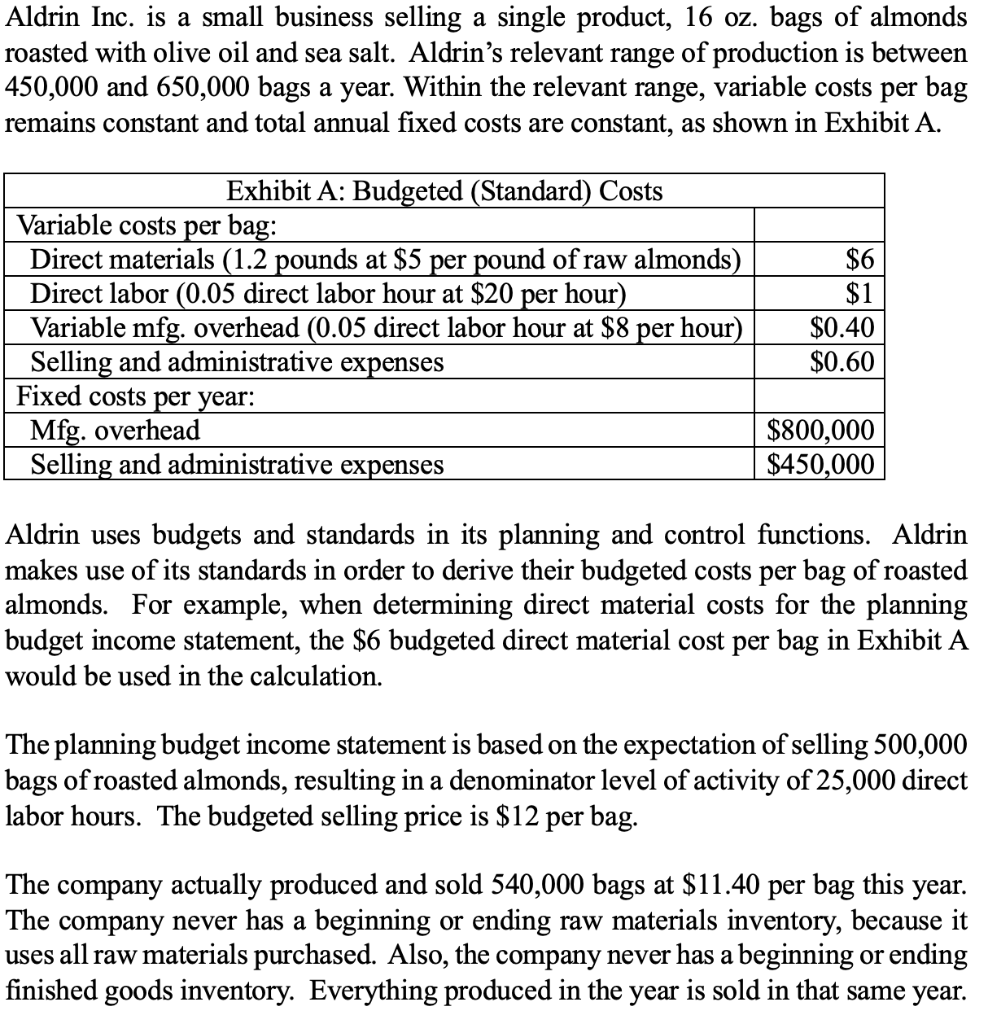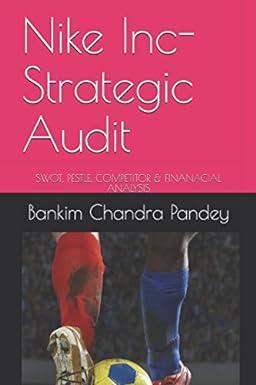


Aldrin Inc. is a small business selling a single product, 16 oz. bags of almonds roasted with olive oil and sea salt. Aldrins relevant range of production is between 450,000 and 650,000 bags a year. Within the relevant range, variable costs per bag remains constant and total annual fixed costs are constant, as shown in Exhibit A. Exhibit A: Budgeted (Standard) Costs Variable costs per bag: Direct materials (1.2 pounds at $5 per pound of raw almonds) $6 Direct labor (0.05 direct labor hour at $20 per hour) $1 Variable mfg. overhead (0.05 direct labor hour at $8 per hour) $0.40 Selling and administrative expenses $0.60 Fixed costs per year: Mfg. overhead $800,000 Selling and administrative expenses $450,000 Aldrin uses budgets and standards in its planning and control functions. Aldrin makes use of its standards in order to derive their budgeted costs per bag of roasted almonds. For example, when determining direct material costs for the planning budget income statement, the $6 budgeted direct material cost per bag in Exhibit A would be used in the calculation. The planning budget income statement is based on the expectation of selling 500,000 bags of roasted almonds, resulting in a denominator level of activity of 25,000 direct labor hours. The budgeted selling price is $12 per bag. The company actually produced and sold 540,000 bags at $11.40 per bag this year. The company never has a beginning or ending raw materials inventory, because it uses all raw materials purchased. Also, the company never has a beginning or ending finished goods inventory. Everything produced in the year is sold in that same year. $6,156,000 The actual income statement for the year is provided in Exhibit B. Exhibit B: Aldrin Inc. Actual Income Statement Sales (540,000 bags produced and sold at $11.4 per bag) Less Variable Costs: Direct materials (702,000 pounds at $4.3 per pound) Direct labor (32,400 direct labor hours at $17 per hour) Variable manufacturing overhead Variable selling and administrative costs Contribution margin Less Fixed Costs: Fixed manufacturing overhead costs Fixed selling and administrative costs Net operating income 3,018,600 550,800 272,160 270,000 2,044,440 768,000 455,000 $821,440 Required: 1. Prepare a detailed income statement variance analysis using the contribution approach income statement for the year (i.e., compare the actual income statement with the flexible budget income statement and compare the flexible budget income statement with the planning budget income statement). Show all the revenue, spending, and activity variances appearing in the income statement analysis. A template for answering this question is given below. All variances should be marked with either an "F" for favorable or "U" for unfavorable. Aldrin Variance Case Solution Template for Part 1 Revenue & Actual Spending Flexible Activity Results Variances Budget Variances $$$ $$$ $$$ $$$ Planning Budget $$$ $$$ $$$ $$$ Sales Less V.C. DM DL V-MOH V-S&A CM Less FC F-MOH F-S&A NOI $$$ $$$ $$$ $$$ $$$ $$$ $$$ $$$ $$$ $$$ $$$ $$$ $$$ $$$ $$$ $$$ $$$ $$$ $$$ $$$ $$$ $$$ $$$ $$$ $$$ $$$ $$$ $$$ $$$ $$$ $$$ $$$ $$$ $$$ $$$ $$$ $$$ 2. Suppose your boss Mr. Aldrin is in the process of evaluating how well the company performed in terms of generating revenues and controlling costs. Mr. Aldrin would like to compare the actual income statement with the planning budget income statement. Could you use the variance analysis from Part 1 to persuade him, who is kind of stubborn, that the company should compare the actual income statement with the flexible budget income statement instead? 3. Prepare a very detailed manufacturing cost variance analysis (e.g., calculate the material price variance and quantity variance; the labor rate variance and efficiency variance; the variable overhead rate variance and efficiency variance; and the fixed manufacturing overhead budget variance and volume variance). All variances should be marked with either an F for favorable or U for unfavorable. Show your calculations. 4. Could you reconcile the spending variances in Part 1 with manufacturing cost variances in Part 3? For example, how is the amount of spending variance for direct materials in Part 1 explained by the amounts of the two direct material variances in Part 3? 5. Could you help Mr. Aldrin evaluate the company's performance in controlling direct materials costs by interpreting relevant variances from Part 1 and Part 3









